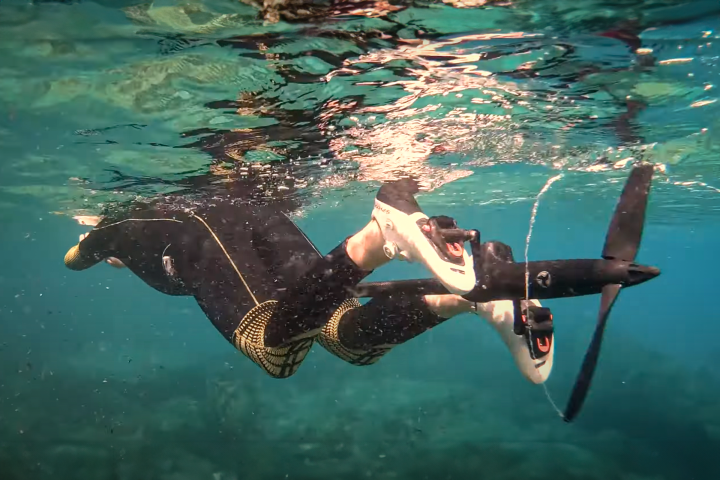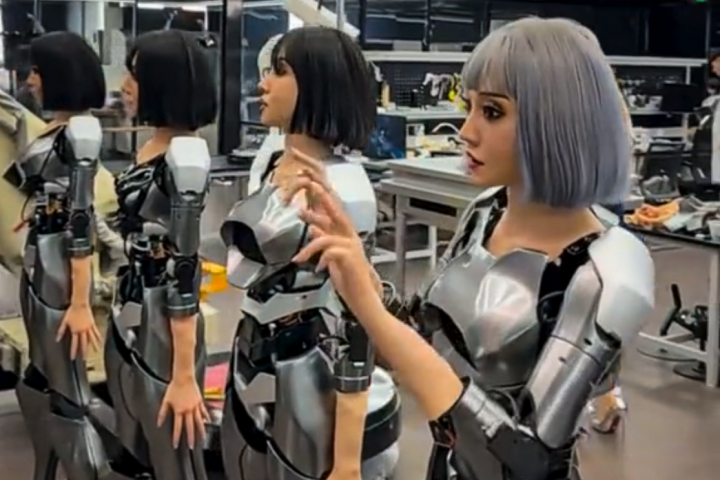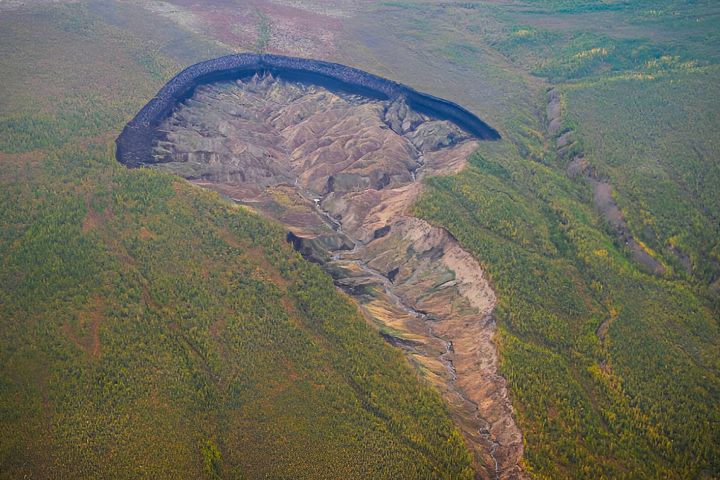In the few weeks following the release of a video that appeared to show jet-ski champion Franky Zapata flying high in the sky on a jet-powered hoverboard, the online community split into two clear camps. On one side of the battlefield, collective jaws were dropping in amazement and wonder. On the other, cries of "fake," "foul" or "fraud" could be heard. On the last day of April we joined Zapata Racing in the south of France to settle the debate once and for all. Oh, and to witness an attempt to remain aloft for more than 280 meters and snatch the "farthest flight by hoverboard" record from Alexandru Duru. That record was pulverized when the Flyboard Air covered over 2 km in around seven minutes. We managed to grab a few words with a jubilant but quite exhausted Franky Zapata after his record-breaking flight.
Jumping straight in, we started our little tête-à-tête with a quick tour of the record-breaking Flyboard Air. Zapata revealed that much of the 20 kg (44 lb) flyer is made from carbon fiber, with four, specially modified for purpose, 250 horsepower jet engines enclosed in an aluminum and steel frame. The jets are fed Jet A-1 kerosene fuel from a backpack, which can be released in less than a second should problems arise. "I just have to press a switch and woosh, the kerosene is gone," he quipped with a confident smile.

Bolted to the top of the eye-catching, angular platform are a pair of white and black ski-like boots, each flanked by a 70 mm JP electric ducted fan powered by a LiPo battery that helps with stability. A computer system running a proprietary algorithm helps keep the Flyboard Air stable by increasing or decreasing each jet automatically.
"The problem is that you have to develop an algorithm that's able to keep you stable, but doesn't conflict when it's time to move the machine," he told us. "So the machine has to understand when you want to move or when it's an uncontrollable movement." And that's about all he would tell us about the computer control system.
In his right hand, Zapata grips the same kind of wireless controller as used with the original water-based Flyboard. "When I press my fingers [on the trigger] I increase the thrust. When I move my hand from side to side, it controls the yaw, using a gyro inside – like a Wii remote. When I move my body forward or backward, or to the side, I control the direction where I want to go." A bit like a Segway then. But jet-powered. And flying.
The Flyboard Air is, of course, an experimental platform, but Zapata Racing is now looking into the various aviation rules and regulations needing to be met in order to take the project forward, first in France and then beyond. Zapata believes that it will be classed as "a ULM (Ultra Léger Motorisé) machine like small copters, parachutes with an engine in the back or small airplanes."
Among the few details made available earlier this month was that the Flyboard Air can rise to 10,000 ft, we asked Zapata to elaborate. "We've never been that high, it's just a calculation showing its potential, but we will do it – we'll go to 10,000 ft," he said, with a glint in his eye that indicated serious intent. "The physical potential of the machine is to go to 10,000 ft, the reality today is that we've never been more than 30 meters (100 ft). It's the same as saying that the machine can reach about 150 km/h, based on our calculations, but in reality I've never passed more than 80 km/h."

The Zapata Racing team has been working on the current version of the Flyboard Air for around a year, though its development is built on a good deal of previous work. The very first flight was aboard an electric Air, and it didn't go quite as planned.
"The machine started on its own and caught two of my fingers. The machine started flying in the workshop, and breaking walls. It was a terrifying moment, because it was a LiPo battery inside. So after I caught it, the board exploded. Fire everywhere." This incident put the brakes on the project ... for a while.
"My wife got very scared and I had to promise her not to do this again. But after a few weeks, I told her I can't stop my nature so I have to move forward with this thing. When I decide to do something, it's an obsession." So work on the jet-powered Flyboard Air began again.
"We placed the jet engine in different ways that was logical for us, but it didn't work. We first did calculations, but the problem is that no-one really knows what works. Even the best engineers in the world don't understand where you have to place the gravity centers on the machine, judging stress and body movements. You cannot find these things on the Internet. So we had to imagine something, then try, try, try."
"We developed a little jet engine that we'd be able to catch in our hands, and with the hands we did a lot of tests to understand how it moved. By moving the small version of the jet engine in the air, we understood exactly where we had to place our hands, and so where we had to place our feet [on the bigger version]. Step by step we increased the reliability, ease of use etc. etc."

All told Zapata has spent only an hour and a half to two hours in the air on the current version of the Flyboard Air, but with the fuel backpack only able to carry enough kerosene for between four to 10 minutes per trip, that's actually quite a bit of fly time. He told us that the range of the Air is just a question of how much kerosene you're able to carry.
We wondered if anyone else on the team was able to pilot the jet-powered hoverboard, dropping huge hints that we would very much like to suit up and take flight along the coast of the Mediterranean.
"No, not yet. First because of not having enough skill on the water Flyboard at the moment. And Second, I prefer to get hurt myself rather than my friends or children getting hurt." The training required is a minimum of 50 hours on the water-based Flyboard, and demonstrating a significant skill level, before you're able to jump on this machine.
With a working Flyboard Air, and a distance record, in the bag, thoughts are already turning to developing a new generation of flying devices. Machines that people would be able to go to work on. The plan at the moment is to build something riders can sit on, just start and go. "Like a flying machine from Star Wars." Something that doesn't require the rigorous training needed to pilot the current machine – something like a flying motorcycle.
"I think in the next few months, we will be able to have this machine working. Our goal is to first help the army or French security to work against terrorism, like what happened in Paris. If you have a flying board or flying motorcycle, you can take off in 30 seconds and catch the people in minutes. The motorcycle will carry the fuel, so it will be able to fly for almost 30 minutes at 300 km/h."
And naturally, there's also talk of taking the Flyboard Air to the skies again to beat his already impressive Guinness World Record. "I can do something like four times more easily. I can fly for 8 km easily."
You can see the official Flyboard Air world record video below.
Source: Zapata Racing

























